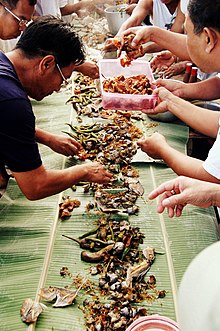 Kamayan as applied through a boodle fight | |
| Alternative names | kinamo, kinamut |
|---|---|
| Place of origin | Philippines |
| Other information | Sadya |


| Part of a series on |
| Meals |
|---|
 |
| Meals |
| Components and courses |
| Related concepts |
Kamayan is a Filipino cultural term for the various occasions or contexts in which pagkakamay (Tagalog: "[eating] with the hands") is practiced,[1][2] including as part of communal feasting (called salu-salo in Tagalog).[3][4][5] Such feasts traditionally served the food on large leaves such as banana or breadfruit spread on a table, with the diners eating from their own plates.[6][7] The practice is also known as kinamot or kinamut in Visayan languages.[citation needed]
While kamayan started out as a common folkway before the arrival of European colonizers, its culturally significance has become elevated in the Philippines' postcolonial culture, since the practice of pagkakamay had been discouraged by the Philippines' Spanish and American colonizers.[8]
A separate[8][9] tradition which involves eating with the hands straight off the table is the boodle fight, a tradition of the Armed Forces of the Philippines originally practiced by Philippine Military Academy cadets,[10] and drawn from a similar tradition at the United States Military Academy West Point.[8] The intent is to build military camaraderie by getting military personnel to enjoy the same food together, regardless of rank.[10]
Among restaurants outside of the Philippines, however, the term "boodle fight" has often been conflated with "kamayan" and "salo-salo," and the terms tend to be used synonymously when marketing the Filipino food experience.[9][11][12]
- ^ Cordero-Fernando, Gilda. 1976. The Culinary Culture of the Philippines. Manila, Philippines: Bancom Audiovision Corporation.
- ^ Doreen G. Fernandez, “Food and the Filipino,” in Philippine World-View, Virgilio G. Enriquez, ed. (Singapore: Institute of Southeast Asian Studies, 1986), pp. 20–44
- ^ "The practice of kamayan and how it fosters Pinoy pride". Rappler. 11 December 2018. Retrieved 22 August 2021.
- ^ Makalintal, Bettina (20 January 2018). "With A Show Of Hands, Filipino-American Chefs Rekindle Kamayan Feasts". NPR. Retrieved 22 August 2021.
- ^ Abbey, Francis (18 November 2019). "Love and pork - The Filipino feast you eat with your hands". WUSA9. Retrieved 22 August 2021.
- ^ Cite error: The named reference
Mendiolawas invoked but never defined (see the help page). - ^ Cite error: The named reference
Ivatanwas invoked but never defined (see the help page). - ^ a b c Bender, D. E., & De Leon, A. (2018). Everybody was boodle fighting: military histories, culinary tourism, and diasporic dining. Food, Culture & Society, 21(1), 25–41. https://doi.org/10.1080/15528014.2017.1398469
- ^ a b Yap, Liz. "A Seat at the Table". Out of Print. Archived from the original on 2021-04-10. Retrieved 2024-04-07.
- ^ a b "Kadayawan's Boodle Fight by Park Inn". SunStar. 23 August 2015.
- ^ Marcaida, Joana Joyce (26 August 2015). "The boodle fight". Retrieved 16 June 2017.[permanent dead link]
- ^ "What is a Boodle Fight? - Ang Sarap". Ang Sarap (A Tagalog word for "It's Delicious"). 2015-05-21. Retrieved 2020-02-10.
© MMXXIII Rich X Search. We shall prevail. All rights reserved. Rich X Search
